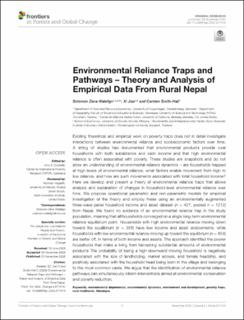| dc.contributor.author | Walelign, Solomon Zena | |
| dc.contributor.author | Jiao, Xi | |
| dc.contributor.author | Smith-Hall, Carsten | |
| dc.date.accessioned | 2022-05-03T12:31:31Z | |
| dc.date.available | 2022-05-03T12:31:31Z | |
| dc.date.created | 2020-11-25T06:57:44Z | |
| dc.date.issued | 2020 | |
| dc.identifier.citation | Frontiers in Forests and Global Change. 2020, 3 . | en_US |
| dc.identifier.issn | 2624-893X | |
| dc.identifier.uri | https://hdl.handle.net/11250/2993944 | |
| dc.description.abstract | Existing theoretical and empirical work on poverty traps does not in detail investigate interactions between environmental reliance and socioeconomic factors over time. A string of studies has documented that environmental products provide rural households with both subsistence and cash income and that high environmental reliance is often associated with poverty. These studies are snapshots and do not allow an understanding of environmental reliance dynamics – are households trapped at high levels of environmental reliance, what factors enable movement from high to low reliance, and how are such movements associated with total household income? Here we develop and present a theory of environmental reliance traps that allows analysis and explanation of changes in household-level environmental reliance over time. We propose operational parametric and non-parametric models for empirical investigation of the theory and employ these using an environmentally augmented three-wave panel household income and asset dataset (n = 427, pooled n = 1212) from Nepal. We found no evidence of an environmental reliance trap in the study population, meaning that all households converged on a single long-term environmental reliance equilibrium point. Households with high environmental reliance moving down toward the equilibrium (n = 358) have low income and asset endowments; while households with low environmental reliance moving up toward the equilibrium (n = 854) are better off, in terms of both income and assets. The approach identified the poorer households that make a living from harvesting substantial amounts of environmental products The probability of being a high-downward moving household is negatively associated with the size of landholding, market access, and female headship, and positively associated with the household head being born in the village and belonging to the most common caste. We argue that the identification of environmental reliance pathways can simultaneously inform interventions aimed at environmental conservation and poverty reduction. | en_US |
| dc.language.iso | eng | en_US |
| dc.publisher | Frontiers | en_US |
| dc.rights | Navngivelse 4.0 Internasjonal | * |
| dc.rights.uri | http://creativecommons.org/licenses/by/4.0/deed.no | * |
| dc.title | Environmental Reliance Traps and Pathways – Theory and Analysis of Empirical Data From Rural Nepal | en_US |
| dc.title.alternative | Environmental Reliance Traps and Pathways – Theory and Analysis of Empirical Data From Rural Nepal | en_US |
| dc.type | Peer reviewed | en_US |
| dc.type | Journal article | en_US |
| dc.description.version | publishedVersion | en_US |
| dc.source.pagenumber | 15 | en_US |
| dc.source.volume | 3 | en_US |
| dc.source.journal | Frontiers in Forests and Global Change | en_US |
| dc.identifier.doi | 10.3389/ffgc.2020.571414 | |
| dc.identifier.cristin | 1851956 | |
| cristin.ispublished | true | |
| cristin.fulltext | original | |
| cristin.qualitycode | 1 | |

